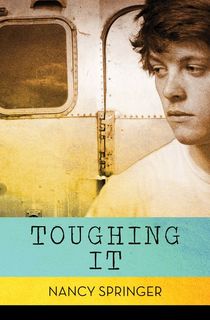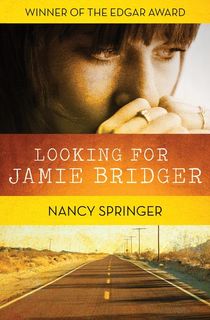From sometime very near the beginning of my 50-year writing career, I knew I would never write mystery. I loved to read mystery, but I was a character-directed writer, a seat-of-the-pants-er, not a plotter. I wrote fantasy, women's fiction, and contemporary fiction for young adults, but mystery? All those ruses and red herrings? Forget it.
Related: The Best Enola Holmes Mysteries for Clever Sleuths of All Ages
Supporting myself and my family by fiction writing, I did not sit waiting for the muse; I gave myself assignments. One of these was to write a novel for reluctant readers, specifically teenage boys. To grab their attention, I killed off the protagonist's brother on page one and proceeded from there. My first reader, my teenage daughter, told me I had to tell readers who murdered the brother, but I disagreed; this was a story about grief, I said. However, the editor seconded my daughter, and eventually, sighing, I managed to figure out the murder. The book was Toughing It, and to my utmost astonishment, it won an Edgar Allen Poe Award from the Mystery Writers of America! I considered this a fluke; I did not write mystery.

Toughing It
Winner of the Edgar Award: When Tuff’s brother is killed, he loses the best friend he ever had—but he may be about to find the father he never knew.
However, I had to change my mind the following year, when my middle-grade novel Looking for Jamie Bridger won another Edgar Award. It appeared I could write mystery of a sort. So I started selling a few stories to Alfred Hitchcock’s Mystery Magazine and Ellery Queen's Mystery Magazine. But a short while later an important editor asked me for a novel about Mordred—King Arthur's incestuous son—and I was delighted to write literary fantasy set in the Camelot mythos, followed up by a series about Robin Hood's daughter. Years later, mystery was the farthest thing from my mind when my editor phoned with his idea of what to do next.
He said, “I want you to write something set in deepest, darkest London at the time of Jack the Ripper.”
Whaaat? This was such a far cry from Camelot and Sherwood Forest that I wanted nothing to do with it. For several days I dithered. Victorian London? I needed a mythos I loved, the way I had loved King Arthur and Robin Hood since childhood, memorizing my mother's books. What else on her bookshelves had I read so devotedly?
Her complete set of Arthur Conan Doyle.
Sherlock Holmes???
Eureka! His was a mythos thick as London pea soup fog! And he was the ideal foil for a strong female protagonist. I thought of giving him a daughter, but that idea lasted only a nanosecond; such was the dignity of Holmes that I could not conceive of his ever having engaged in the reproductive act. A younger sister, then? Yes! And instantly, even before figuring out the logistics and fixing on a time chart, I knew her name: Enola.
Related: 8 Books for Fans of Enola Holmes Mysteries
The way I instantly realized her name felt uncanny. But I had long been aware of Victorian female names such as Perdita, the lost one, and Dolores, the sad one, and Isola, and Enola—which backwards spells alone. Of course, Sherlock and Mycroft Holmes's sister would be Enola, “alone.” I knew this with absolute certainty, although I did not until years later piece together precisely how I knew: I had two much older brothers myself.

Looking for Jamie Bridger
Winner of the Edgar Award: A search to find her parents becomes a quest that shakes Jamie Bridger’s identity to its core.
Also, I had a mother who had been very much preoccupied with her watercolors...But, brainstorming the Enola Holmes books, I was not questioning why these story ideas came to me. I was thinking, in a bit of a panic, that I needed to research. I had never written historical fiction. Blessedly, I had read a lot of Victorian fiction, but still, there was so much I needed to learn!
I plunged into reading biographies of Enola's contemporaries as well as tons of nonfiction pertaining to the era. And I spent weeks watching Jeremy Brett's television performance of Sherlock Holmes over and over. I also ordered lovely parcels of great stuff from Dover Books, including stickers, paper dolls, and coloring books. Unexpectedly, the annotated coloring books turned out to be the most powerful learning tool I had. Nothing helped me internalize the material I was learning like using my new Prismacolor pencils on every little object in those coloring book pictures.
Related: WATCH: Millie Bobby Brown Is a Bold Young Sleuth in the New Enola Holmes Trailer
When I began to write, Enola was such a strong character she led me by the nose, sometimes to places I didn't want to go. It became irrelevant that I was trying to write a historical mystery for the very first time; I just wrote. And by golly, I found myself learning to plot. Each novel required me to braid together three plots: Enola trying to find her mother, Enola escaping from the clutches of her brothers, and Enola on a mission to locate a missing person. Creating these books gave me a daily workout and made me mentally sweat. They led me into new territory as a writer. The day I sent the initial manuscript to my agent, I had butterflies in my stomach for the first time in years, terrified of any negative reaction. Why? I was an old pro. What was different about these books?

The Case of the Missing Marquess
Meet Enola Holmes, teenaged girl-turned-detective and the younger sister to Sherlock Holmes. Now a Netflix original movie starring Millie Bobby Brown, Henry Cavill, and Helena Bonham Carter!
Oh, no.
I began to get it. Enola had polite yet distant family relations. She had spent her childhood running wild, a friendless oddity, yet society expected that she would grow up to conform to restrictive norms. She couldn't. She wouldn't...To a much greater extent than I had previously realized, Enola was me.
What was to become of her?
I was actually quite frightened, those early days. But as I write this—contemplating the Netflix movie based on my book series—I am deeply satisfied to know that all has turned out well. And I am touched to think how many people loved Enola after all.

